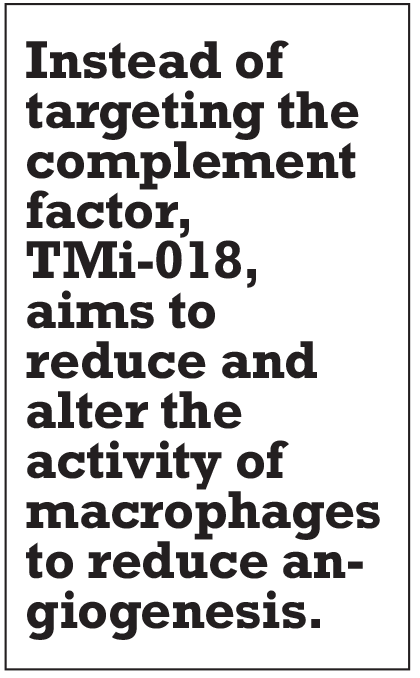You don’t have to read it here to know there’s no approved treatment for the dry form of age-related macular degeneration, but that fact is pivotal in drug-development programs Translatum Medicus is pursuing. Instead of targeting the complement factor in macular degeneration, its lead candidate, TMi-018, aims to reduce and alter the activity of macrophages to reduce angiogenesis.
TMi-018 is a first-in-class transcriptional modulator. As a small synthetic molecule, it has been shown to be stable and suitable for both short- and long-term delivery. Focusing first on the short-acting formulation, Translatum (TMi) has demonstrated its efficacy in preclinical studies and is currently in preclinical safety studies, says Shelley Boyd, MD, FRCSC, TMi president and chief executive officer. She says that TMi is currently preparing its investigational new drug (IND) application with the Food and Drug Administration, approval of which will then enable Phase I/IIa studies.
 |
It’s worth noting that Dr. Boyd is also a practicing retina specialist. She’s director of the High-Risk Dry AMD Clinic at St. Michael’s Hospital, Toronto, and an assistant professor at the University of Toronto. She’s also the former head of the global ocular angiogenesis research program at Novartis during the early in-licensing and development of ranibizumab (Lucentis) with Genentech.
But developing clinical trials for dry AMD can be a challenge. It involves enrolling patients late in the disease course and measuring their rate of geographic atrophy expansion. Reflecting on her Novartis experience, Dr Boyd notes that just as researchers developing anti-VEGF agents used angiogenesis as a paradigm for neovascular AMD in animal studies, the team developing TMi-018 is focusing on atrophy and developed a model that has demonstrated a reduction in both GA onset and expansion with the agent.
The work in TMi-018 is predicated on the activity of macrophages. For example, Dr. Boyd notes that drusen regression can predict late-stage AMD, and believes this reflects local activation of the macrophage population.
Macrophages and monocyte chemoattractant protein-1 (MCP1) have been found in eyes with both GA and neovascularization.1,2 Previous studies have demonstrated the plasticity of macrophage polarization.3 The goal of TMi-018 is to neutralize macrophage behavior at the mRNA level, altering the “transcriptome,” the repertoire of genes expressed.
TMi is pursuing three programs for TMi-018: the short-acting formulation in dry AMD, which is the most advanced and is now in the preclinical safety phase; a slow-release formulation that is in preclinical research and development; and a program in diabetic retinopathy, which is also in the preclinical R&D phase.
Here, David S. Boyer, MD, a principal partner at Retina-Vitreous Associates Medical Group in Los Angeles, answers questions about TMi-018. Dr. Boyer is a scientific adviser to and an investor in TMi.
How does TMi-018 potentially target dry AMD?
Evidence has shown that macrophages drive inflammation, tissue damage and even angiogenesis. Modulation of the macrophages may be able to downregulate inflammasomes and the complement system. We know that in the absence of macrophages, neovascular AMD doesn’t occur. Also, levels of MCP1 are elevated in anterior chamber samples in eyes with dry AMD.
Please describe the mechanism of action in your own words.
TMi-018 modulates the macrophage response, therefore avoiding activation of the inflammatory and potentially the angiogenic response. Macrophages are increased in geographic atrophy, drusen and neovascularization. This approach could reduce secretion of vascular endothelial growth factor and control angiogenesis.
What is the rationale for targeting dry AMD with TMi-018?
Because dry macular degeneration is a chronic condition, short-term formulations aren’t practical for the patient or the clinician. TMi has elected to work with synthetic molecules rather than biologics and has already demonstrated their long-term stability and suitability for extended release. Long-acting formulations may include nanoparticles or other long-acting solutions.
What have the preclinical studies shown about the efficacy of the short-acting formulation?
Since there are no good animal models for dry macular degeneration, TMi has devised an in vivo model that mimics dry atrophic macular degeneration. The experiments performed on the patch used in the studies have shown a dose-dependent protection for the formation of geographic atrophy and for expansion.
What are the next steps in the development of TMi-018?
The next steps are to take this technology into the clinic to prove its effectiveness. Once the effectiveness of the treatment is established, this technology can be used to prevent progression or development of GA. With CMC (chemistry, manufacturing and control) nearing completion, the next step will be IND regulatory approval, and a Phase I/IIa safety and dose-escalating study. Once the ideal dose has been identified, a Phase II study can be undertaken.
REFERENCES
1. Sennlaub F, Auvynet C, Calippe B, et al. CCR2(+) monocytes infiltrate atrophic lesions in age-related macular disease and mediate photoreceptor degeneration in experimental subretinal inflammation in Cx3cr1 deficient mice. EMBO Mol Med. 2013;5:1775-1793.
2. Cao X, Shen D, Patel MM, et al. Macrophage polarization in the maculae of age-related macular degeneration: A pilot study. Pathol Int. 2011;61:528–535.
3. Sica A, Mantavani A. Macrophage plasticity and polarization: In vivo veritas. J Clin Invest. 2012;122:787-795.



